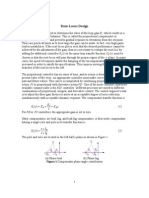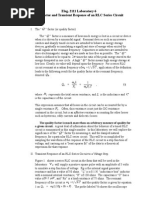Z-Plane RL Design Using MATLAB: 2.1 Plant
Uploaded by
pra_zara2637Z-Plane RL Design Using MATLAB: 2.1 Plant
Uploaded by
pra_zara2637ME 481/581
Chapter 5
February 29, 2012
Z-Plane RL Design using MATLAB
Introduction.
This document is intended to give you an example of using MATLAB and root locus to design controllers (compensators) in the z-plane.
2
2.1
Plant and Specifications.
Plant.
The plant will be an pure unit inertia; this could be any rotary element in a low-friction environment. The general
transfer function from applied torque to angular position for a pure inertia is
1
1
(s)
=
= 2 (unit inertia)
2
(s)
Js
s
2.2
(1)
Specification.
I arbitrarily selected the closed-loop natural frequency to be 100 Hz and damping of 0.707, along with a sampling
frequency of fs =500 Hz (T =0.002). This corresponds to desired s-plane and z-plane pole locations of
p
s = n jn 1 2 444 j444.
(2)
z = esT = 0.2596 + j0.3192 0.26 + j0.32
(3)
This sampling frequency is quite low; we would typically sample at perhaps 20 the bandwidth (natural frequency).
2.3
Discretized Plant.
With T =0.002, the zoh-discretized model of the plant (found using MATLAB c2d) is:
>> Gc = tf([0 0 1],[1 0 0])
Transfer function:
1
--s^2
>> Gd = c2d(Gc,T)
Transfer function:
2e-06 z + 2e-06
--------------z^2 - 2 z + 1
Sampling time: 0.002
This can be expressed as
G(z) =
(2e 6)(z + 1)
(2e 6)z + (2e 6)
=
z 2 2z + 1
(z 1)2
Note the small numerator constant of 2e 6; that will probably be counteracted by a large forward path gain.
(4)
ME 481/581
Chapter 5
February 29, 2012
Compensator Design.
Proportional control will be tried first, then a lead compensator.
3.1
Proportional Control.
With proportional control the actuating signal sent to the plant is proportional to the error signal, hence the compensator is a pure gain K.
3.1.1
Closed-Loop Transfer Function.
With system input called R(z) and system controlled variable (output) called Y (z) the closed-loop transfer function
W (z) is
KG(z)
Y (z)
=
R(z)
1 + KG(z)
(5)
1 + KG(z) = 0
(6)
hence the system characteristic equation is
This is already in root locus form.
3.1.2
Root Locus of Proportional Control.
Using equation (6) we can draw the MATLAB root locus:
>> rlocus(Gd); axis equal; grid;
Zooming in on the locus near the +1 point we get the figure below:
Root Locus
0.4/T
0.3/T
0.7
0.6
0.2/T
Imaginary Axis
0.5
0.4
0.3
0.1/T
0.2 0.5/T
0.1
0.1
0.2
0.3
0.4
0.5
0.6
0.7
0.8
0.9
0.6/T
0.2
0.4
0.6
0.8
Real Axis
1.2
1.4
The locus (blue line) starts from the double pole at z = 1 and goes outside the unit circlethis system is unstable.
ME 481/581
3.2
Chapter 5
February 29, 2012
Lead Compensator.
We need to improve the stability of this system. A lead compensator (a quasi-differentiator) will do that. This can be
seen from two perspectives:
A lead network will pull the locus to the left, thus keeping it inside the unit circle
A lead network adds positive phase angle, thereby improving the phase margin
The structure of a lead compensator D(z) is
D(z) =
z+b
z+a
(7)
where the zero is closer to the +1 point than the pole.
3.2.1
Compensator Pole/Zero Locations.
My philosophy on lead compensator design is to place the compensator zero in the s-plane at about one-third the
distance of the desired dominant poles. Thus if the desired poles are at 445 j445 Id place the compensator zero
at about 445/3 150. Now in the z-plane this zero location would be
z = esT = e(150)(0.002) 0.74 = D(z) =
z 0.74
z+a
(8)
The location of the compensator pole is found using the root-locus angle condition, in which we use open-loop transfer
function D(z)G(z):
(angles of vectors from poles to desired pole) (angles of vectors from zeros to desired pole) = 180
(9)
The relevant values in this problem are:
The open-loop poles: -1, -1, and the unknown lead compensator pole
The open-loop zeros: 0.74, -1
The desired closed-loop pole: 0.26+j0.32
I suggest you draw the z-plane and draw these vectors. Here are the values that I found:
2(156 ) + 146 14 = 180
(10)
Parameter in (10) is the angle of the vector from the lead compensator pole to the desired closed-loop pole location.
From (10) this angle is
= 28
(11)
This implies that the pole must be located at z = 0.354, thus the lead compensator is
D(z) =
z 0.74
z + 0.35
(12)
The root-locus diagram of D(z)G(z) is shown on the next page; the cross shows where I specified the desired pole
(near = 0.6).
The corresponding K at this point is:
K = 3.14e5 = 314, 000
Remember the small numerator constant in G(z)? This K makes up for it.
(13)
ME 481/581
Chapter 5
February 29, 2012
Root Locus
0.6/T
0.5/T
0.4/T
0.8
0.1 0.3/T
0.7/T
0.2
0.3
0.6
0.2/T
0.4
Imaginary Axis
0.5
0.4 0.8/T
0.6
0.7
0.1/T
0.8
0.2 0.9/T
0.9
/T
0
/T
0.2 0.9/T
0.1/T
0.8/T
0.7/T
0.6/T 0.5/T 0.4/T
0.3/T
0.2/T
0.4
0.5
0.5
Real Axis
Final Closed-Loop System.
With the D(z) and G(z) given previously, the closed-loop transfer function is
Y (z)
KD(z)G(z)
=
R(z)
1 + KD(z)G(z)
(14)
Using MATLAB, this is
>> Wd = feedback(K*Dd*Gd,1)
Transfer function:
0.6287 z^2 + 0.1635 z - 0.4652
----------------------------------z^3 - 1.017 z^2 + 0.4555 z - 0.1112
Sampling time: 0.002
>> damp(Wd)
Eigenvalue
Magnitude
Equiv. Damping
Equiv. Freq. (rad/s)
5.58e-01
2.29e-01 + 3.83e-01i
2.29e-01 - 3.83e-01i
5.58e-01
4.46e-01
4.46e-01
1.00e+00
6.16e-01
6.16e-01
2.91e+02
6.54e+02
6.54e+02
The complex closed-loop poles have a damping ratio of 0.65 and a natural frequency of 654 rad/s (104 Hz). Id say
our design is pretty close.
One could get the step response, etc.
Since this is a Type II system, it should definitely have a DC gain of 1.00; from MATLAB we get
>> dcgain(Wd)
ans = 1
You might also like
- Lab 4 - Motor Speed Control With Lead Compensator and Integral ControlNo ratings yetLab 4 - Motor Speed Control With Lead Compensator and Integral Control7 pages
- Module 5: Design of Sampled Data Control Systems: Lecture Note 3No ratings yetModule 5: Design of Sampled Data Control Systems: Lecture Note 36 pages
- Effect of Pole and Zero On Stability With ExampleNo ratings yetEffect of Pole and Zero On Stability With Example13 pages
- DC Motor Position Digital Controller DesignNo ratings yetDC Motor Position Digital Controller Design15 pages
- 351 - 27435 - EE411 - 2015 - 1 - 1 - 1 - 0 3 EE411 Lec6,7 Compensation RLNo ratings yet351 - 27435 - EE411 - 2015 - 1 - 1 - 1 - 0 3 EE411 Lec6,7 Compensation RL47 pages
- Direct Expressions For Ogata's Lead-Lag Design Method Using Root LocusNo ratings yetDirect Expressions For Ogata's Lead-Lag Design Method Using Root Locus2 pages
- Open-Loop Speed Control of A DC Motor: Abidur Rahman Sagor 18-38599-2No ratings yetOpen-Loop Speed Control of A DC Motor: Abidur Rahman Sagor 18-38599-25 pages
- Lecture - 5 - Lead - Compensation Design by The Time Response Method1No ratings yetLecture - 5 - Lead - Compensation Design by The Time Response Method152 pages
- Extras: Designing Lead and Lag Compensators: SystemNo ratings yetExtras: Designing Lead and Lag Compensators: System6 pages
- Compensator Design To Improve Transient Performance Using Root LocusNo ratings yetCompensator Design To Improve Transient Performance Using Root Locus35 pages
- Dcs Experimentno5 New Sarvesh 16103a0047No ratings yetDcs Experimentno5 New Sarvesh 16103a00475 pages
- Control Systems LAB # 8 Design Via Root Locus: Example: Find The Root Locus For The T.F Matlab CodeNo ratings yetControl Systems LAB # 8 Design Via Root Locus: Example: Find The Root Locus For The T.F Matlab Code6 pages
- Root Locus Based Design: Effects of Addition of Poles and ZerosNo ratings yetRoot Locus Based Design: Effects of Addition of Poles and Zeros12 pages
- Controller Design Using Root-Locus TechniquesNo ratings yetController Design Using Root-Locus Techniques10 pages
- Lecture 380-26-192 Design Via Root LocusNo ratings yetLecture 380-26-192 Design Via Root Locus24 pages
- Control Systems Analysis and Design by The Root Locus Method 2No ratings yetControl Systems Analysis and Design by The Root Locus Method 293 pages
- 351 - 27435 - EE419 - 2016 - 1 - 2 - 1 - 0 3 EE419 Lec6,7 Compensation RLNo ratings yet351 - 27435 - EE419 - 2016 - 1 - 2 - 1 - 0 3 EE419 Lec6,7 Compensation RL47 pages
- Digital Control Systems (DCS) : Lecture-1-2 Lead CompensationNo ratings yetDigital Control Systems (DCS) : Lecture-1-2 Lead Compensation61 pages
- Experiment Name:: Modeling of A Control System Using Root LocusNo ratings yetExperiment Name:: Modeling of A Control System Using Root Locus8 pages
- Project Report Designing Position Control System: Abu Dhabi UniversityNo ratings yetProject Report Designing Position Control System: Abu Dhabi University13 pages
- American International University-Bangladesh (AIUB) Faculty of EngineeringNo ratings yetAmerican International University-Bangladesh (AIUB) Faculty of Engineering10 pages
- Experiment 106. Stabilisation of A Rotary Inverted Pendulum 1 ObjectiveNo ratings yetExperiment 106. Stabilisation of A Rotary Inverted Pendulum 1 Objective11 pages
- Hardware Development Tools: 2009 Texas Instruments, All Rights ReservedNo ratings yetHardware Development Tools: 2009 Texas Instruments, All Rights Reserved38 pages
- CMOS Fabrication Technology and Design RulesNo ratings yetCMOS Fabrication Technology and Design Rules17 pages
- Eleg. 2111 Laboratory 6 "Q" Factor and Transient Response of An RLC Series CircuitNo ratings yetEleg. 2111 Laboratory 6 "Q" Factor and Transient Response of An RLC Series Circuit9 pages
- Electric-Fusion-Welded Steel Pipe For Atmospheric and Lower TemperaturesNo ratings yetElectric-Fusion-Welded Steel Pipe For Atmospheric and Lower Temperatures7 pages
- Revised Blooms Taxonomy Process Verbs Assessments and Questioning StrategiesNo ratings yetRevised Blooms Taxonomy Process Verbs Assessments and Questioning Strategies2 pages
- Lecture 3 - Variables Constants and Data TypesNo ratings yetLecture 3 - Variables Constants and Data Types34 pages
- Session 8 - BIOL343 - Kefilwe Rafedile - 28oct2021No ratings yetSession 8 - BIOL343 - Kefilwe Rafedile - 28oct202113 pages
- The Institution of Engineers BangladeshiebNo ratings yetThe Institution of Engineers Bangladeshieb105 pages
- The Visible Light Quiz Google Forms PRINTEDNo ratings yetThe Visible Light Quiz Google Forms PRINTED4 pages
- 694739279-Physics-project-on-SemiconductorNo ratings yet694739279-Physics-project-on-Semiconductor25 pages
- How To Become Millionare in 5 Years or LessNo ratings yetHow To Become Millionare in 5 Years or Less5 pages
- Quantum Speed Reading As A Quasi Telepathic Commun100% (4)Quantum Speed Reading As A Quasi Telepathic Commun26 pages
- S. No Basis of Comparison Baseband Transmission Broadband TransmissionNo ratings yetS. No Basis of Comparison Baseband Transmission Broadband Transmission2 pages
- ISO 50001: Setting The Standard For Industrial Energy ManagementNo ratings yetISO 50001: Setting The Standard For Industrial Energy Management4 pages
- Junior Assistant in Telangana State Road Transport CorporationNo ratings yetJunior Assistant in Telangana State Road Transport Corporation23 pages
- Lab 4 - Motor Speed Control With Lead Compensator and Integral ControlLab 4 - Motor Speed Control With Lead Compensator and Integral Control
- Module 5: Design of Sampled Data Control Systems: Lecture Note 3Module 5: Design of Sampled Data Control Systems: Lecture Note 3
- 351 - 27435 - EE411 - 2015 - 1 - 1 - 1 - 0 3 EE411 Lec6,7 Compensation RL351 - 27435 - EE411 - 2015 - 1 - 1 - 1 - 0 3 EE411 Lec6,7 Compensation RL
- Direct Expressions For Ogata's Lead-Lag Design Method Using Root LocusDirect Expressions For Ogata's Lead-Lag Design Method Using Root Locus
- Open-Loop Speed Control of A DC Motor: Abidur Rahman Sagor 18-38599-2Open-Loop Speed Control of A DC Motor: Abidur Rahman Sagor 18-38599-2
- Lecture - 5 - Lead - Compensation Design by The Time Response Method1Lecture - 5 - Lead - Compensation Design by The Time Response Method1
- Extras: Designing Lead and Lag Compensators: SystemExtras: Designing Lead and Lag Compensators: System
- Compensator Design To Improve Transient Performance Using Root LocusCompensator Design To Improve Transient Performance Using Root Locus
- Control Systems LAB # 8 Design Via Root Locus: Example: Find The Root Locus For The T.F Matlab CodeControl Systems LAB # 8 Design Via Root Locus: Example: Find The Root Locus For The T.F Matlab Code
- Root Locus Based Design: Effects of Addition of Poles and ZerosRoot Locus Based Design: Effects of Addition of Poles and Zeros
- Control Systems Analysis and Design by The Root Locus Method 2Control Systems Analysis and Design by The Root Locus Method 2
- 351 - 27435 - EE419 - 2016 - 1 - 2 - 1 - 0 3 EE419 Lec6,7 Compensation RL351 - 27435 - EE419 - 2016 - 1 - 2 - 1 - 0 3 EE419 Lec6,7 Compensation RL
- Digital Control Systems (DCS) : Lecture-1-2 Lead CompensationDigital Control Systems (DCS) : Lecture-1-2 Lead Compensation
- Experiment Name:: Modeling of A Control System Using Root LocusExperiment Name:: Modeling of A Control System Using Root Locus
- Project Report Designing Position Control System: Abu Dhabi UniversityProject Report Designing Position Control System: Abu Dhabi University
- American International University-Bangladesh (AIUB) Faculty of EngineeringAmerican International University-Bangladesh (AIUB) Faculty of Engineering
- Experiment 106. Stabilisation of A Rotary Inverted Pendulum 1 ObjectiveExperiment 106. Stabilisation of A Rotary Inverted Pendulum 1 Objective
- Hardware Development Tools: 2009 Texas Instruments, All Rights ReservedHardware Development Tools: 2009 Texas Instruments, All Rights Reserved
- Eleg. 2111 Laboratory 6 "Q" Factor and Transient Response of An RLC Series CircuitEleg. 2111 Laboratory 6 "Q" Factor and Transient Response of An RLC Series Circuit
- Electric-Fusion-Welded Steel Pipe For Atmospheric and Lower TemperaturesElectric-Fusion-Welded Steel Pipe For Atmospheric and Lower Temperatures
- Revised Blooms Taxonomy Process Verbs Assessments and Questioning StrategiesRevised Blooms Taxonomy Process Verbs Assessments and Questioning Strategies
- Session 8 - BIOL343 - Kefilwe Rafedile - 28oct2021Session 8 - BIOL343 - Kefilwe Rafedile - 28oct2021
- Quantum Speed Reading As A Quasi Telepathic CommunQuantum Speed Reading As A Quasi Telepathic Commun
- S. No Basis of Comparison Baseband Transmission Broadband TransmissionS. No Basis of Comparison Baseband Transmission Broadband Transmission
- ISO 50001: Setting The Standard For Industrial Energy ManagementISO 50001: Setting The Standard For Industrial Energy Management
- Junior Assistant in Telangana State Road Transport CorporationJunior Assistant in Telangana State Road Transport Corporation































































































